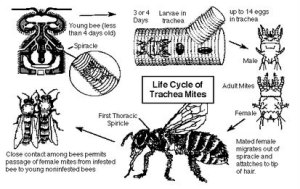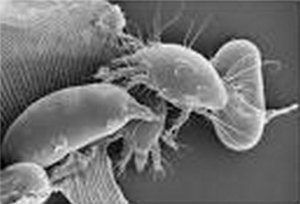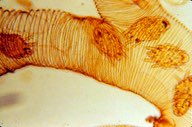Tracheal Mites (Acrapis woodi):
- Reduces brood production.
- Increases winter honey consumption.
- Reduces annual honey production.
- 70% colony loss over winter.
Biology and Effects to Colonies
The tracheal mite is a serious pest of honey bees, even though damage to colonies is more variable and less severe than varroa mites. Colonies vary in their susceptibility to tracheal mites because of differences in colony genetics and regional and year to year with environmental conditions. Nonetheless epidemic winter colony losses of up to 70% and severe reductions in colony productivity due to tracheal mites have been reported. Tracheal mites not only infect workers, but also queens and drones.

|
Various life stages of tracheal mite. |
Tracheal mites are tiny microscopic mites that spend almost their entire life in the prothoracic trachea (breathing tubes), located just above the bees front pair of legs. Mite feeding, development, and reproduction take place in the trachea. Female mites migrate to the surface of the bee to locate new hosts once mated. Dispersing female mites have a strong preference for newly emerged bees and rarely invade the trachea of older bees. The ability of mites to select young bees is strongly driven by odors exclusive to the cuticle of newly emerged bees. Treatment of colonies with vegetable oil and sugar patties masks the odor, thus confusing tracheal mites and slowing their dispersal. Continuous treatment with vegetable oil, in conjunction with an annual formic acid treatment provides excellent control of tracheal mites in most cases.

|
Mature female tracheal mite on the surface hairs of its bee host. The mite’s front legs are outstretched as it prepares to crawl off onto a new host. Vegetable oil patties can reduce tracheal mite dispersal. Formic acid kills mites still in the trachea. |
The proportions of tracheal mite infested bees steadily increase in untreated colonies through fall, winter and early spring. Colonies become weakened and are at high risk of collapse when greater than 30% of the bees are infested by tracheal mites.
Research shows that colonies with a dual infestation of varroa and tracheal mites can be much more severe than when either mite is present on its own. Colony losses can be extremely rapid. Managing both mites is critical to maintaining healthy productive honey bee colonies.
Diagnosis
Unlike varroa mites, tracheal mites are not visible without bee dissection and the aid of a microscope. External visible symptoms include:
- Colonies that die in spring or winter despite ample honey stores.
- Bees have disjointed wings and seem unable to fly.
Unfortunately, external visible symptoms are not diagnostic and may be confused with other colony problems. Definitive diagnosis requires dissection of bees for the presence or absence of the microscopic mites.
Tracheal mites are located in the prothoracic trachea, which emerge on the sides of the thorax just above the front pair of legs. Samples of adult bees collected from beneath the inner cover can be used to determine the level of infestation in apiaries or particular colonies. Contact local state or provincial apiculture inspector for more information about the collection and analysis of bees for tracheal mites.

|

|
| Removal of head and prothorax collar reveals two trachea trunks. Trunksabove are healthy. | Trunks above are infested with tracheal mites. Infested trachea are darkened by scaring. |
Treatment
More Information
